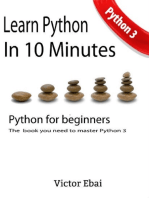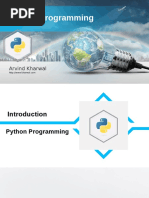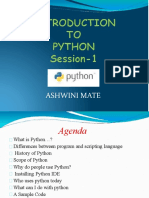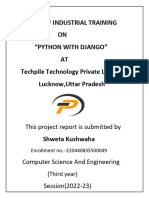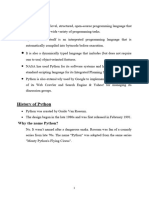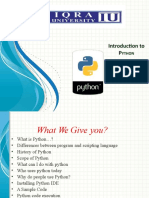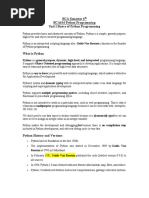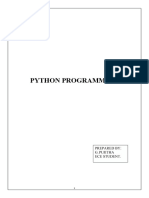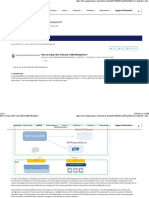0 ratings0% found this document useful (0 votes)
22 views2 - Introduction To Python Programming
Introduction to python programming
Uploaded by
smallikarjun713Copyright
© © All Rights Reserved
We take content rights seriously. If you suspect this is your content, claim it here.
Available Formats
Download as PDF, TXT or read online on Scribd
0 ratings0% found this document useful (0 votes)
22 views2 - Introduction To Python Programming
Introduction to python programming
Uploaded by
smallikarjun713Copyright
© © All Rights Reserved
We take content rights seriously. If you suspect this is your content, claim it here.
Available Formats
Download as PDF, TXT or read online on Scribd
You are on page 1/ 19
• Presentation By Uplatz
• Contact us: https://training.uplatz.com
• Email: info@uplatz.com
• Phone: +44 7836 212635
Learning outcomes:
• What is Python Programming?
• History of Python Programming
• Features of Python
• Application of Python
• Setup of Python Programming
• Getting started with the first
Python program
What is Python Programming?
• Python is a high level, interpreted, intelligent,
and object-oriented scripting language.
• Python is handled at runtime by the interpreter.
You don't need to compile your code before
executing it.
• Python is very interesting and easy to learn
language. Learning of Python Programming is as
easier as C language.
• Python's simple, easy to learn syntax
emphasizes readability and therefore reduces
the cost of program maintenance.
What is Python Programming?
• Python supports modules and packages, which
encourages program modularity and code
reuse.
• The Python interpreter and the extensive
standard library are available in source or binary
form without charge for all major platforms,
and can be freely distributed.
History of Python Programming
• Python was created by Guido van Rossum.
• The design began in the late 1980.
• Soon after that, Guido Van Rossum began doing
its application based work in December of 1989
by at Centrum Wiskunde & Informatica (CWI)
which is situated in Netherland.
• The first release was on February 1991.
History of Python Programming
“Python is an experiment in how much freedom
programmers need. Too much freedom and
nobody can read another's code. Too little and
expressiveness is endangered.”
- Guido van Rossum
History of Python Programming
Why Python was created?
• In late 1980s, Guido Van Rossum was working
on the Amoeba distributed operating system
group.
• He wanted to use an interpreted language like
ABC (ABC has simple easy-to-understand syntax)
that could access the Amoeba system calls.
• So, he decided to create a language that was
extensible. This led to design of a new language
which was later named Python.
History of Python Programming
Why the name Python?
• It wasn't named after a dangerous snake.
• Rossum was fan of a comedy series from late
seventies.
• The name "Python" was adopted from the same
series "Monty Python's Flying Circus".
Features of Python Programming
Python is Interpreted: Python is processed at runtime by
the interpreter. You do not need to compile your program
before executing it. This is similar to PERL and PHP.
Python is Interactive: You can actually sit at a Python
prompt and interact with the interpreter directly to write
your programs.
Python is Object-Oriented: Python supports Object-
Oriented style or technique of programming that
encapsulates code within objects.
Python is a Beginner's Language: Python is a great
language for the beginner-level programmers and supports
the development of a wide range of applications from
simple text processing to WWW browsers to games.
Features of Python Programming
• A simple language which is easier to learn
• Free and open-source
• Portability
• Extensible and Embeddable
• A high-level, interpreted language
• Large standard libraries to solve common tasks
• Free and open source
• GUI Programming
Application of Python Programming
• Web Development.
• Game Development.
• Scientific and Numeric Applications.
• Artificial Intelligence and Machine Learning.
• Software Development.
• Enterprise-level/Business Applications.
Education programs and training courses.
• Language Development.
• Desktop GUI
• Web Scraping Applications
• Business Applications
Setup of Python Programming
Getting Python:
The most up-to-date and current source code,
binaries, documentation, news, etc., is available on
the official website of Python:
http://www.python.org/.
You can download Python documentation from
www.python.org/doc/. The documentation is
available in HTML, PDF, and PostScript formats.
Setup of Python Programming
Installation of Python:
• Python distribution is available for a wide
variety of platforms.
• Python can be obtained from the Python
Software Foundation website at python.org.
Typically, that involves downloading the
appropriate installer for your operating system
and running it on your machine.
Setup of Python Programming
Installation of Python:
Here are the steps to install Python on Windows
operating system.
1. Open a Web browser and go to
http://www.python.org/download/
2. click on “Download Python 3.9.0” (You may see
different version name). You can download
some other version as per your choice.
3. When the download is completed, double-click
the file and follow the instructions to install it.
4. Just accept the default settings, wait until the
install is finished, and you are done.
Setup of Python Programming
When Python is installed, a program called IDLE is
also installed along with it. It provides graphical
user interface to work with Python.
Getting started with the first Python
program
• Open IDLE
• To create a file in IDLE, go to File > New File
(Shortcut: Ctrl+N).
• Write Python code (you can copy the code
below for now) and save (Shortcut: Ctrl+S) with
.py file extension like: hello.py or your-
firstprogram.py
print ("Hello, World!")
Getting started with the first Python
program
Running the first Python Program:
• Before running the python program, you can
save it using Ctrl + S, OR go to File > Save.
• Now you can run the program. Go to Run > Run
module (Shortcut: F5) and you can see the
output.
• Congratulations, you've successfully run your
first Python program.
Output:
Hello, World!
Thank you
You might also like
- Tinywow - 1. Python-Introduction - 10303709No ratings yetTinywow - 1. Python-Introduction - 1030370947 pages
- Python Course - I Getting Started With Python PDFNo ratings yetPython Course - I Getting Started With Python PDF13 pages
- Introductiontopython 140705013157 Phpapp02No ratings yetIntroductiontopython 140705013157 Phpapp0219 pages
- Dept. of Electrical and Electronics Engineering Motihari College of Engineering, MotihariNo ratings yetDept. of Electrical and Electronics Engineering Motihari College of Engineering, Motihari15 pages
- NEW NOTE CSC 201 SCIENTIFIC PROGRAMMING LANGUAGENo ratings yetNEW NOTE CSC 201 SCIENTIFIC PROGRAMMING LANGUAGE18 pages
- LEARN PYTHON PROGRAMMING: A Comprehensive Guide for Beginners to Master Python Programming (2024)From EverandLEARN PYTHON PROGRAMMING: A Comprehensive Guide for Beginners to Master Python Programming (2024)No ratings yet
- Development of Software Using Agile ModelNo ratings yetDevelopment of Software Using Agile Model14 pages
- Sanjivani K. B. P. Polytechnic: Under The Guidance ofNo ratings yetSanjivani K. B. P. Polytechnic: Under The Guidance of14 pages
- The Complete Cloud Computing Software Architecture Patterns - WorkbookNo ratings yetThe Complete Cloud Computing Software Architecture Patterns - Workbook28 pages
- Object Oriented Analysis and Design May 2024No ratings yetObject Oriented Analysis and Design May 20244 pages
- CCS366- STA- Expected Questions with ans- IAT-1No ratings yetCCS366- STA- Expected Questions with ans- IAT-16 pages
- Introduction to Low Code Application Development with Oracle APEX - Course outlineNo ratings yetIntroduction to Low Code Application Development with Oracle APEX - Course outline3 pages
- How To Setup TAFC CALLJEE in IBM Websphere?No ratings yetHow To Setup TAFC CALLJEE in IBM Websphere?17 pages
- [Ebooks PDF] download Pro Spring Boot 2: An Authoritative Guide to Building Microservices, Web and Enterprise Applications, and Best Practices 2nd Edition Felipe Gutierrez full chapters100% (6)[Ebooks PDF] download Pro Spring Boot 2: An Authoritative Guide to Building Microservices, Web and Enterprise Applications, and Best Practices 2nd Edition Felipe Gutierrez full chapters55 pages
- Module 7 - Inserting Tables Module 7 - Inserting Tables - PDF - HTML Element - InternetNo ratings yetModule 7 - Inserting Tables Module 7 - Inserting Tables - PDF - HTML Element - Internet1 page
- Beginning Java MVC 1 0 Model View Controller Development to Build Web Cloud and Microservices Applications 1st Edition Peter Spath Späth Peter - Download the ebook and explore the most detailed content100% (2)Beginning Java MVC 1 0 Model View Controller Development to Build Web Cloud and Microservices Applications 1st Edition Peter Spath Späth Peter - Download the ebook and explore the most detailed content65 pages
